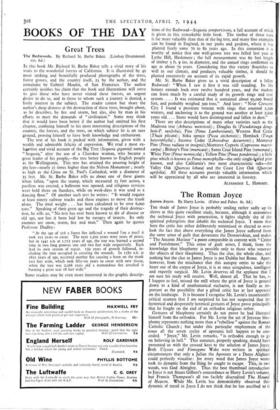BOOKS OF THE DAY
Great Trees
IN this book Mr. Richard St. Barbe Baker tells a vivid story of his visits to the wonderful forests of California. It is illustrated by 42 most striking and beautifully produced photographs of the trees, forest groves, and the country itself, 25 by the author, and the remainder by Gabriel Moulin, of San Francisco. The author certainly justifies his claim that the book and illustrations will serve to give those who have never visited these forests, an urgent desire to do so, and to those to whom such a journey is denied, a lively interest in the subject. The reader cannot but share the author's deep distress at the destruction of these trees, brought about, as he describes, by fire and storm, but alas, also by man in his efforts to meet the demands of " civilisation." Some may think that it would have been better if the author had omitted his first chapter, confining himself to his most interesting descriptions of the country, the forests, and the trees, on which subject he is on sure ground, proving himself to have both knowledge and enthusiasm.
The text of his book is packed with information, given with a wealth and admirable felicity of expression. We read a most ex- haustive and vivid account of the Big Tree (Sequoia gigantia) named " Sequoia," after the son of a Cherokee woman, who became a great leader of his people,—the tree better known to English people as the Wellingtonia. This tree has attained the amazing height of 365 feet—nearly 24 times higher than the Nelson Monument ; nearly as high as the Cross on St. Paul's Cathedral, with a diameter of 35 feet. Mr. St. Barbe Baker tells us about one of these giants when fallen, " upon the stump, which measured 25 feet across, a pavilion was erected, a ballroom was opened, and religious services were held there on Sundays, while on week-days it was used as a dancing floor." Of another such tree he writes : " It would require at least ninety railway trucks and three engines to move the trunk alone. The total weight . . . has been calculated to be over 6,000 tons." Speaking of their great age and the tragedy of their destruc- tion, he tells us, " No tree has ever been known to die of disease or old age, nor has it been laid low by ravages of insects. Its only enemies arc snow, storm, fire and man." Then again he quotes. Professor Dudley :
' " At the age of 516 a forest fire inflicted a wound [on a treel it
took 105 years to cover. The next 1,200 years were years of peace, but in 1441 A.D. at 1,712 years of age, the tree was burned a second
time in two long grooves one and two feet wide respectively. Each had its own system of repair. 139 years of growth followed, in-
cluding the time occupied in covering the wounds. In 1580 A.D. at 1851 years of age, occurred another fire causing a burn on the trunk two feet wide, which took fifty-six years to cover with new tissue, when the tree was 2,068 years old a tremendous fire attacked it burning a great scar 18 feet wide."
Some readers may be even more interested in the graphic descrip-
tions of the Redwood—Sequoia sempervirens, a full account of which is given in this remarkable little book. The timber of these trees is far more valuable than that of the big tree, and many fine examples can be found in England, in our parks and gardens, where it was planted freely some 70 to 8o years ago. In this connexion it is worthy of notice that one well-grown tree was felled last year at Lythe Hill, Haslemere ; the full measurement was 6o feet length of timber 3 ft. 9 ins, in diameter, and the annual rings confirmed its age as about 7o years. Considering that this variety flourishes so well in our climate, and produces valuable timber, it should be planted extensively on account of its rapid growth.
Mr. St. Barbe Baker gives us a vivid description of a fallen Redwood.: " When I saw it first it was still 'standing. Its life history extends back over twelve hundred years, and the student can learn much by a careful study of its growth rings and root system. . . . It was estimated that it contained about 95,000 board feet, and probably weighed Soo tons." And later : "Near Crescent City I found a prostrate veteran with rings that counted 1,500 winters, and anchoring it to the ground was another at least 2,000 years old.... Stone would have disintegrated and fallen to dust."
There are also descriptions of many other varieties such as the Madrona tree (Arbutus menziesii) • Douglas fir (Pseuclotsuga doug- lasii-P. taxifolia); Pine (Pinus Lantberticma); Western Red Cedar (Thuja plicate); Sitka spruCe (Picea sitchensis); Hemlock (Tsuga heterophylla)Incense Cedar (Libocedrus decurrens) ; Monterey Pine (Pinus r;cliata or insignis);Monterey Cypress (Cupressus macro- carpa) ; Bishop's Pine (muricata); Santa Cruz Island Pine (remorata); `White Pine (Pinus monticola) ; Yellow Pine (Pinus ponderosa) ; a little pine which is known as Pinus monophylle—the only single-kafed pine known, and also California's two most characteristic oaks—the Valley Oak (Quercus lobate) and the Coast Live Oak (Quercus agrifolia). All these accounts provide valuable information which will be appreciated by all who are interested in forestry.
ALEXANDER L. HOWARD.


























 Previous page
Previous page